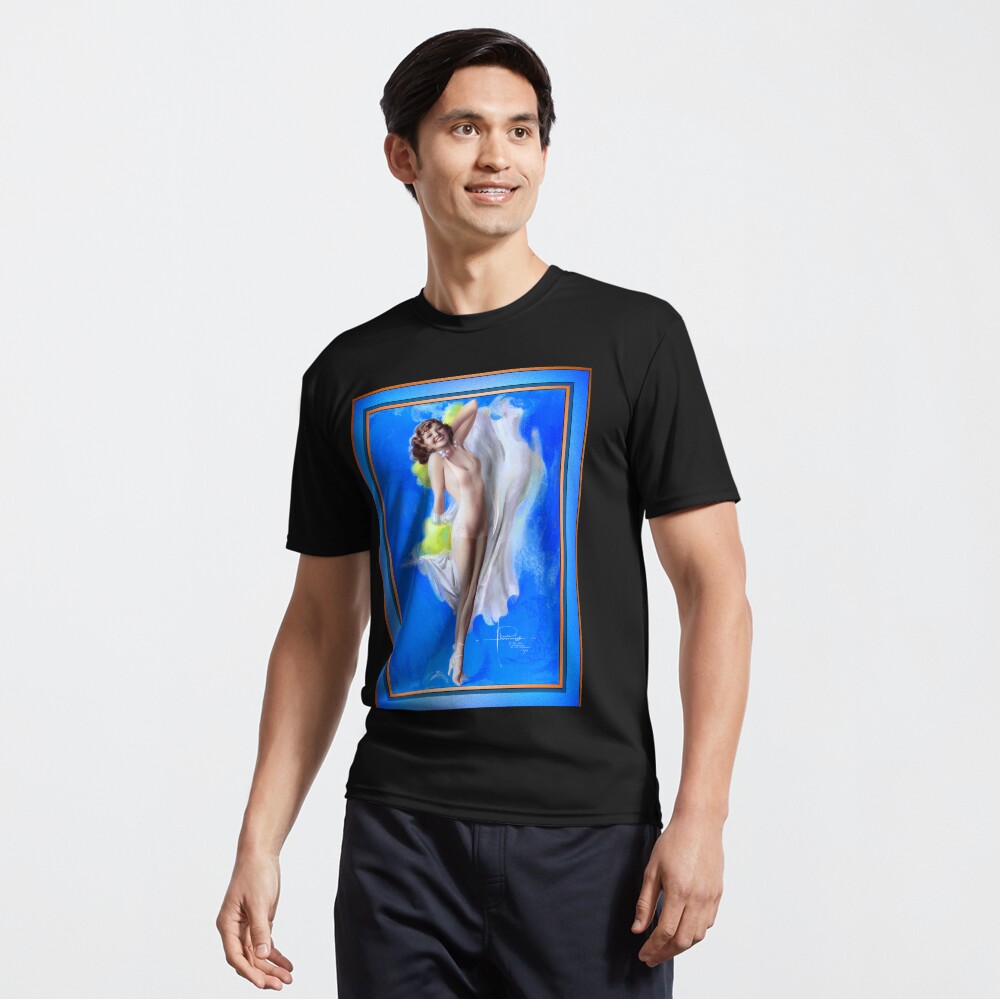
Showgirl
Showgirl by American Artist Rolf Armstrong (1889 – 1960); Artis Pinup, Pelukis lan Ilustrator, lan sing dianggep dadi godfather saka Amérika Pin-up Art.
This is flashy flowing form pinup girl illustration of an attractive brunette in a pink one piece bathing suit, with attached white and pink flowers attached to the straps of the suit, and a matching high heel pink lace up shoes that is a showgirl.

She is standing with her legs crossed, dening, and leaning on a white table with blue accents along the perimeter with her right hand; she is also wearing a silver band on her right forearm with a bright yellow cloth wrapped around it.
She has her left hand behind her head and we can see more of the same yellow cloth with some feathers protruding from it; and then there is a large white cloth or drape off to her left side that is also on the table that blends into the background of various shades of abstract blue.
Showgirl is a remastered digital art old masters reproduction of a public domain image that is available as an acrylic, canvas and metal print online.
Info Below From Wikipedia.org
Rolf Armstrong was born John Scott Armstrong in Bay City, Michigan on April 21, 1889, to Richard and Harriet (Scott) Armstrong. His father owned the Boy-Line Fire Boat Company, which included a line of passenger ships. Some were deployed in Chicago for use at the Chicago World’s Fair there in 1893.
However, the father’s business and family were struggling, and the family homestead was lost to foreclosure. Ing 1899, the family moved to Detroit, Michigan. Rolf’s father died in 1903, and a year later he and his mother moved to Seattle, Washington, following the footsteps of his oldest brother, William, who had moved there a year earlier. By now Rolf’s artistic interests were emerging to more than a part-time pleasure.
He moved to Chicago in 1908, where he later studied at the Art Institute. He then went on to New York, where he studied with Robert Henri. After a trip to Paris in 1919 to study at the Académie Julian, he returned to New York and established a studio. Ing 1921 he went to Minneapolis to study calendar production at Brown & Bigelow.
During the 1920s and 1930s, his work appeared on many pieces of sheet music, as well as on the covers of many magazines, most famously for movie fan magazines such as Photoplay and Screenland. His work mostly consists of women; Mary Pickford, Bebe Daniels, and Greta Garbo are just a few of the numerous he painted.
Armstrong’s work for the Pictorial Review was largely responsible for that magazine achieving a circulation of more than two million by 1926. A year later, he was the best-selling calendar artist at Brown & Bigelow. Ing 1930, RCA hired him to paint pin-ups to advertise their products, and in 1933 the Thomas D. Murphy Calendar Company signed him to produce a series of paintings for their line.
In March 1940, Jewel Flowers, a girl from Lumberton, North Carolina, sent a picture of herself to Armstrong in response to an advert he had placed in the New York Times. Armstrong, 50 at the time, had been based at the Hotel des Artistes on West 67th Street in Manhattan since 1939, and was looking for new models.
He invited Flowers for an interview. On March 25, 1940, Flowers started modeling for Armstrong. Their professional collaboration and friendship lasted for two decades. The first painting, titled “How am I doing?”, reportedly because Flowers, unused to modeling, repeatedly asked Armstrong “How am I doing?” during the modeling session, was first published after World War II had started.
It was Brown & Bigelow’s best selling calendar for 1942 at a time when the company sold millions of calendars in America, and it became one of Armstrong’s most reproduced pictures. Flowers was popular with American servicemen during World War II, some of whom sent her letters proposing marriage. Armstrong’s calendars and silhouettes of Flowers were copied onto bombers and other planes as nose art and painted on tank turrets.
She became so well known during the war, although more as a famous face than by name, that a serviceman’s letter addressed simply as “Jewel Flowers, New York City” was delivered correctly. For many American servicemen abroad, she represented the “Why We Fight” spirit. U.S. President Franklin D. Roosevelt’s government enlisted her to help promote war bonds.
The January 1, 1945 edition of TIME magazine included Armstrong’s “Toast of the Town” painting of Flowers in an article about Calendar Art. The article noted that calendars with “girl paintings” were “bought heavily by foundries, machine shops, auto-supply dealers.”
Flowers married in 1946. She and her husband lived in several places while he tried a number of business ventures, including Laguna Beach, California, Greenville, South Carolina, Reno, Nevada, where she reportedly worked in as a card dealer for a time, and New York City. According to Michael Wooldridge, coauthor of Pin up Dreams: The Glamour Art of Rolf Armstrong, Armstrong called her a number of times during the period she was following her husband from place to place, to try to persuade her to return to New York and model for him.
Her modeling career ended with Armstrong’s death in 1960. He left a large proportion of his personal wealth to Flowers. In total, Armstrong created around fifty to sixty works using Flowers as the model.
Rolf Armstrong died in 1960 on the island of Oahu, Hawaii as one of the best “pin-up” artists of the first half of the twentieth century.




